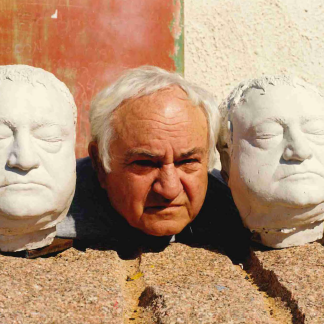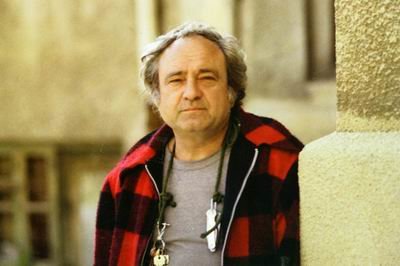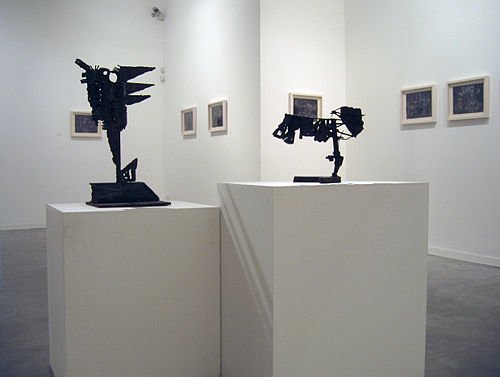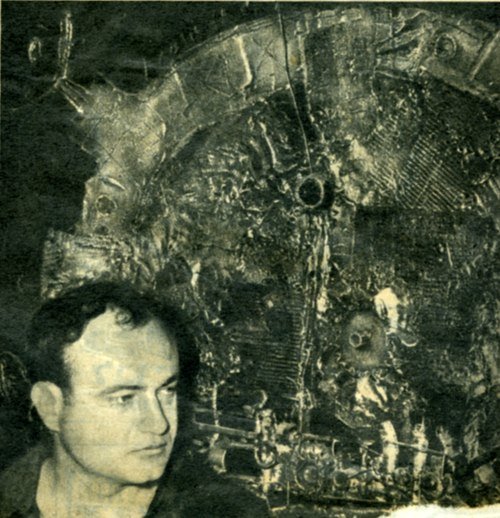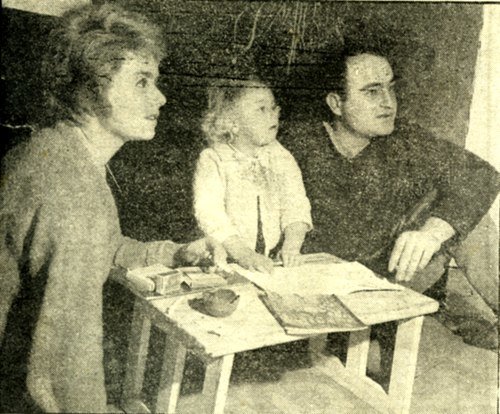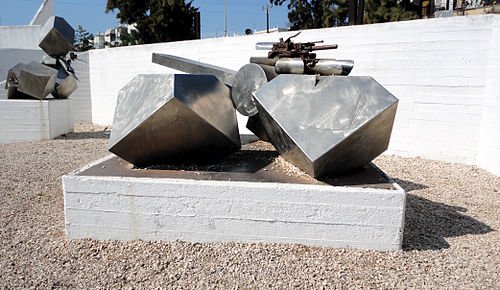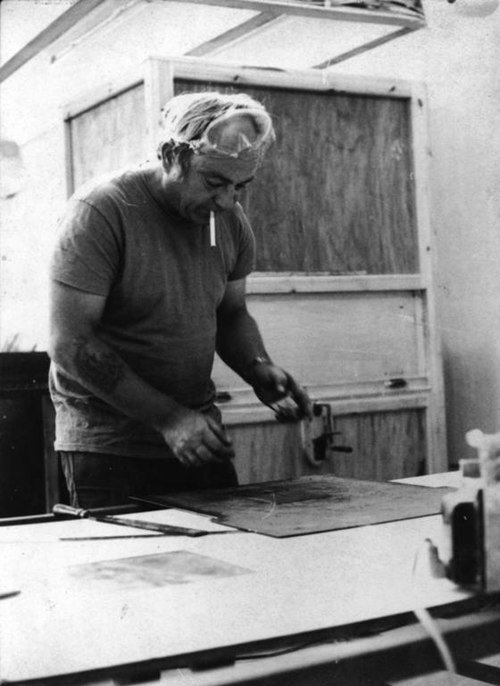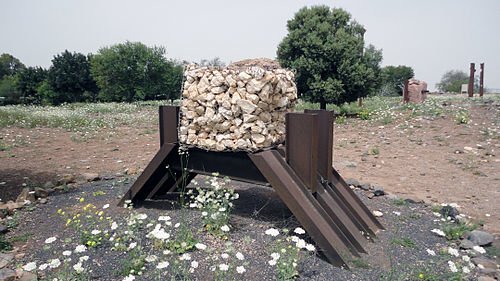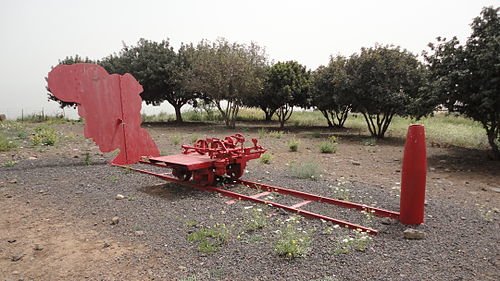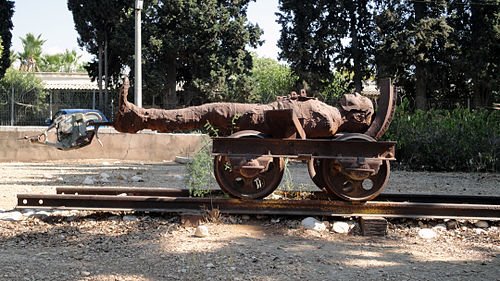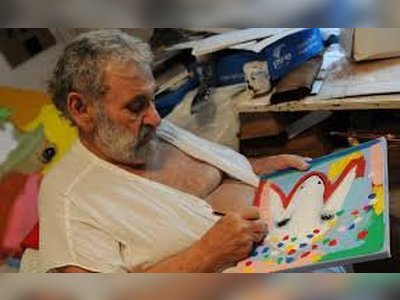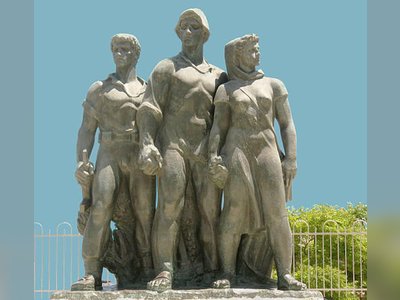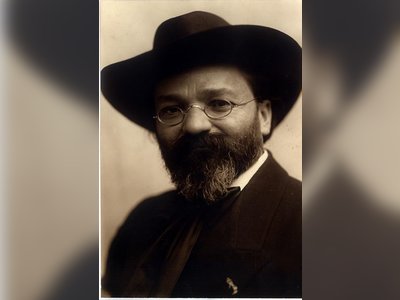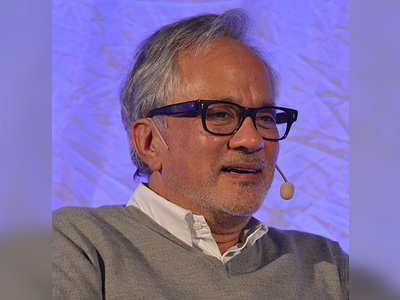Yigael Tomarkin
Yigael Tomarkin (original name: Peter Martin Gregor Heinrich Hellberg; October 23, 1933 – August 12, 2021) was an Israeli artist, sculptor, illustrator, writer, and graphic artist. His significance in the history of Israeli art lies in his contributions to sculpture and painting, which reflected the influence of Pop art in the 1960s and were based on assemblage techniques.
Throughout his career, Tomarkin created numerous sculptures and monuments that were displayed in public spaces in Israel. Despite undergoing various stylistic changes over the years, his work consistently expressed cultural protest and anti-war sentiments, showcasing a deep engagement with Israeli culture. Some of his notable works include the sculpture "He Walked in Fields" (1967) and the Holocaust and Resurrection Memorial (1975). For his overall body of work, Tomarkin was awarded the Israel Prize for Sculpture in 2004.
1933–1954: Childhood and Youth
Born as Peter Martin Gregor Heinrich Hellberg in Dresden, Germany, on October 23, 1933, his mother, Berta Görbitz, was Jewish, while his father, Martin Hellberg, was a German Christian and the son of a priest who later became a well-known director and actor in Germany. His mother brought him to Israel when he was just two years old, and there he was adopted by Hertzel Tomarkin, who became his surrogate father. In 1949, his sister was born. At the age of nine, Tomarkin discovered that he was adopted, which created a sense of detachment from his parents. He later described this experience as, "It caused turbulence because you know they're not speaking the truth to you."
Tomarkin grew up in Tel Aviv and attended the "Bait Hachinuch LeYeladim Ovdim," a school associated with the Workers' Movement. Later, the family moved to Bat Yam, where he attended the religious school "Tachkemoni." In a later interview, Tomarkin described the challenges he faced in this religious environment and his transition between various educational institutions. Among other places, he was sent to study on a kibbutz in the Jezreel Valley, where he spent several months, and then attended "Bait Hachinuch" on Bezalel Street in Tel Aviv, along with other schools affiliated with the Workers' Movement in Bat Yam and Holon.
In 1946, he joined the Hanoar Ha'ivri youth movement. That same year, he enrolled in the professional school "Max Fein," where he studied metalwork and later telecommunications and electronics. In 1949, as a young sailor, he joined two voyages to Europe on the ship "Negbah." Following his military service in the Israeli Navy, Tomarkin began creating amateur sculptures using clay and concrete. In 1952, he was conscripted into the Israel Defense Forces and served as a naval guide in the Shayetet. During his military service and afterward, Tomarkin produced sculptures of animals that were sold in various stores.
In 1954, after his release from the IDF, Tomarkin studied under the sculptor Rudi Lehmann in Ein Hod for about a year. Lehmann's teachings focused on designing figures and shapes that were detached from both academic and avant-garde realism. Tomarkin recalled his relationship with Lehmann, saying, "When he was descending towards me in peace and descending on his way to Jerusalem, I would start counting backward until Rudi arrived, waiting for him at the end of the path, and I would jump on the giant ostrich that roamed slowly on top of the mountain, expecting to show him what I had created in the two weeks he was absent... In the evenings, we would talk about art and sculpture, especially his love for sculpture ranging from a cow to a grasshopper, and especially Shomir and Maori, about the clean shape, about the material's strength, and about the difference between an animal and a human in sculpture." Some of the early works he created during this period include the bronze sculpture "Woman," dated 1955, which featured an image of the Egyptian goddess Isis with a beheaded bird instead of the Egyptian god Horus, who is usually depicted on her head.
In 1955, Tomarkin traveled to East Germany, where he met his biological father for the first time. During his stay in Germany, he had a daughter with a local woman. In a later interview, Tomarkin stated that he had no contact with his daughter or her mother and had only seen his daughter once in his life. His relationship with his biological father was also distant. In Germany, Tomarkin worked as a scenic artist specializing in "Berliner Ensemble," the theater of Bertolt Brecht. Among his independent works during this time was the stage design for a revised version of the play "The Good Person of Szechwan" (1940), which was performed as an experimental production outside Berlin. Tomarkin often mentioned the profound influence of Brecht's figure on his artistry. After Brecht's death in 1956, Tomarkin emigrated to West Germany and later to the Netherlands, where he married his Israeli partner Naomi. He eventually settled in France, where he experienced financial hardship.
In 1959, in Paris, Tomarkin met the poet Tristan Tzara, which exposed him to the art of the Dada movement. He also became familiar with the photomontages of John Heartfield and collages by Kurt Schwitters. Other notable influences included the sculptures of Julio González and César Baldaccini. Under these and other influences, Tomarkin began to formulate his assemblage approach to art. His paintings during this period achieved commercial and artistic success, with one of his works being acquired by the Tate Gallery.
In 1960, encouraged by Danziger, Yona Fischer, and Sam Dubiner, Tomarkin returned to Israel "to stage an exhibition at Bezalel and then return." However, he ended up staying in Israel for an additional two years. In 1961, Tomarkin's first solo exhibition in Israel took place at the Beit HaNadiv art gallery in Jerusalem. Tomarkin wrote that he returned from Paris "with the object and assemblage trend, that poetic garbage that was not known and accepted in the abstract lyrical land."
Tomarkin's works from this period prominently featured the influence of Pop art and avant-garde protest art. In the painting "Panic About Trousers" (1961), one of his famous works from that time, Tomarkin used a pair of stained work pants painted black with added red accents. In the years that followed, he began sculpting various figures and forms using different materials, describing it as "creating absurdity – archeology in the present." In 1961, he traveled to the Negev and constructed models of landscape sculptures. In 1962, he traveled to Japan and the United States to study Japanese painting techniques.
During this period, Tomarkin created monumental sculptures such as "Mitzpor Arad" (1962–1968), which deviated from his earlier figurative work. In his designs, the sculpture symbolizes and shapes a human experience within the landscape, not only in its form and materials but also in its placement, representing the context. Nevertheless, Tomarkin maintained an expressive language in the structural and compositional aspects of his designs.
In 1963, Tomarkin moved to Tel Aviv. That year, he participated in an exhibition of Israeli sculpture held at the Tel Aviv Museum, which also featured the works of other young artists such as Buky Schwartz, Igael Tumarkin, and David Rabinowitch. Tomarkin's works stood out in the exhibition for their assemblage technique and influence of Pop art, prompting the museum to purchase the sculpture "Panic About Trousers." Around that time, Tomarkin also created the "Kiosk" series (1963–1964), in which he expressed his identification with the kiosk, "the essence of Israeliness," through installations composed of discarded signs and panels.
1963–1975: The Years of Protest
Throughout the 1960s, Tomarkin continued to develop his assemblage technique and protest art. His works, often consisting of discarded and found objects, aimed to convey a strong cultural critique and anti-war message. Some of his notable works from this period include:
1. "Soldier's Uniform" (1964): In this work, Tomarkin protested against militarism and the glorification of war. He used a soldier's uniform filled with explosives and a red toy ball as a symbol of the devastating impact of war on young soldiers.
2. "War Totem" (1965): This sculpture features a war helmet mounted on top of a pole, surrounded by barbed wire. It serves as a powerful anti-war statement, reflecting the artist's opposition to conflict and violence.
3. "The War of the Words" (1967): Created during the Six-Day War, this assemblage work incorporated typewriters, army boots, and other objects to convey the chaos and confusion of war.
4. "Burning Memory" (1968): In response to the memory of the Holocaust, Tomarkin created this piece using barbed wire, photographs, and other materials. It serves as a poignant reminder of the atrocities of the past.
5. Holocaust and Resurrection Memorial (1975): This monumental sculpture, located in Rabin Square in Tel Aviv, is one of Tomarkin's most famous works. It consists of three intertwined figures, symbolizing the Jewish people's journey from the Holocaust to rebirth and hope.
Tomarkin's protest art garnered both acclaim and controversy. While some praised his ability to capture the social and political turmoil of the era, others found his works provocative and challenging. Nevertheless, he remained committed to expressing his views through his art.
1975–2021: Later Career and Legacy
In the late 1970s and beyond, Tomarkin's work continued to evolve. He experimented with various materials, including metal, stone, and wood, creating sculptures that explored themes of love, human connection, and the environment. His later works exhibited a more abstract and conceptual style compared to his earlier protest art.
Notable works from his later career include the sculpture "He Walked in Fields" (1967), which is displayed in the Tel Aviv Museum of Art's sculpture garden, and "The Garden of the Missing Soldiers" (1977–1982), located in the Negev Desert, which pays tribute to soldiers who went missing in action.
Yigael Tomarkin's artistic legacy extends beyond his sculptures and assemblages. He was also a prolific writer, illustrator, and graphic artist. His writings include essays, poems, and reflections on art and life. Throughout his career, he exhibited his art in numerous solo and group exhibitions in Israel and abroad.
In 2004, Yigael Tomarkin was awarded the Israel Prize for Sculpture, recognizing his significant contributions to the field of art in Israel. His work continues to be celebrated and studied by art historians, scholars, and enthusiasts, making a lasting impact on Israeli art and the broader world of contemporary sculpture.
Yigael Tomarkin passed away on August 12, 2021, leaving behind a rich and diverse body of work that reflects his deep engagement with societal issues, culture, and the human experience. His legacy endures through his art, which continues to provoke thought and inspire dialogue on important themes such as war, memory, and human connection.
- יגאל תומרקיןhe.wikipedia.org
